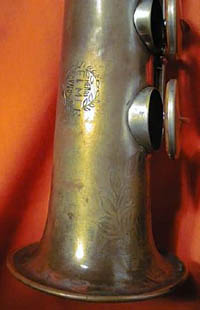Prototypes and the
Selmer American (US or NY) models
Prototypes:
s/n to 750, ca. 1904-1920
Selmer American (US/NY): s/n varies, ca. 1910-1922
I always wondered about the missing 750 horns between the introduction of the Selmer Modele 22 in 1922. I got my answer a couple of months ago when there was a very odd looking Selmer for sale on eBay, which had a serial number of 656. Anyhow, I immediately started bidding on this horn and ALMOST won. I missed by just a bit. Oh, well. I had the pics and started to do research. I was happy to see that there was then ANOTHER of these horns on eBay, almost a year later -- and a more ornate one, at that! RESEARCHING Plus, I knew that Selmer moved to their Dancourt address in 1900. - I sent a couple of e-mail messages to a couple other collectors and they suggested I try to do a bit more research through www.selmer.fr, Selmer's French website. I found it to be significantly different than the US website. I didn't find anything about saxophones produced before 1922, though. - I was browsing the Selmer website and stumbled upon their clarinet timeline. There in big, bold type: "1904 Gold Medal Winner, St. Louis." I had my confimation. The Design ======= * Dr. Paul Cohen, in his article "Selmer Legacies and Myths, Part I" (The Saxophone Journal [May/June 1994]), suggests that Selmer (Paris) also stencilled saxophones from both the A. Sax company and Couesnon. That's a possibility, but there's a couple problems: - There is no extant Adophe-Edward Sax serial number list, so anyone's dating scheme of these horns may be totally inaccurate. When these horns were in production, there were at least three variations: one with range to low B and no roller keys, one with significantly different looking keyguards than these "prototype" horns and ones probably made after Selmer purchased the Sax plant around 1928. Only these latter horns look sufficiently like these "prototypes". - The Cousenon Monopole models look sufficiently like the "prototype" horns pictured here but, as mentioned, they already won a gold medal for their earlier series of instruments -- and did not win in 1904. Additionally, there are some differences in keywork shape. However, a Cousenon origin is the strongest argument against Selmer manufacture until I can find more pictures or get further documentation from Selmer (Paris). - In Dr. Cohen's article, he publishes an ad for "Selmer Saxophones (Paris)" that he dates to 1922, that says that the horns pictured are the "Modele 22", but the design is significantly different than all 22's I've seen, but not very far removed from these "prototypes". Couesnon stencil? |
Website copyright © 1997-2002 by Pete Hales.
Pictures/sounds/etc. used herein may have their own copyright and most are used by permission.
If you feel any image or soundbyte used here is in violation of copyright or for information regarding use/reproduction of this website's content, please e-mail saxpics@gmail.com
Comments, corrections or suggestions: saxpics@gmail.com

